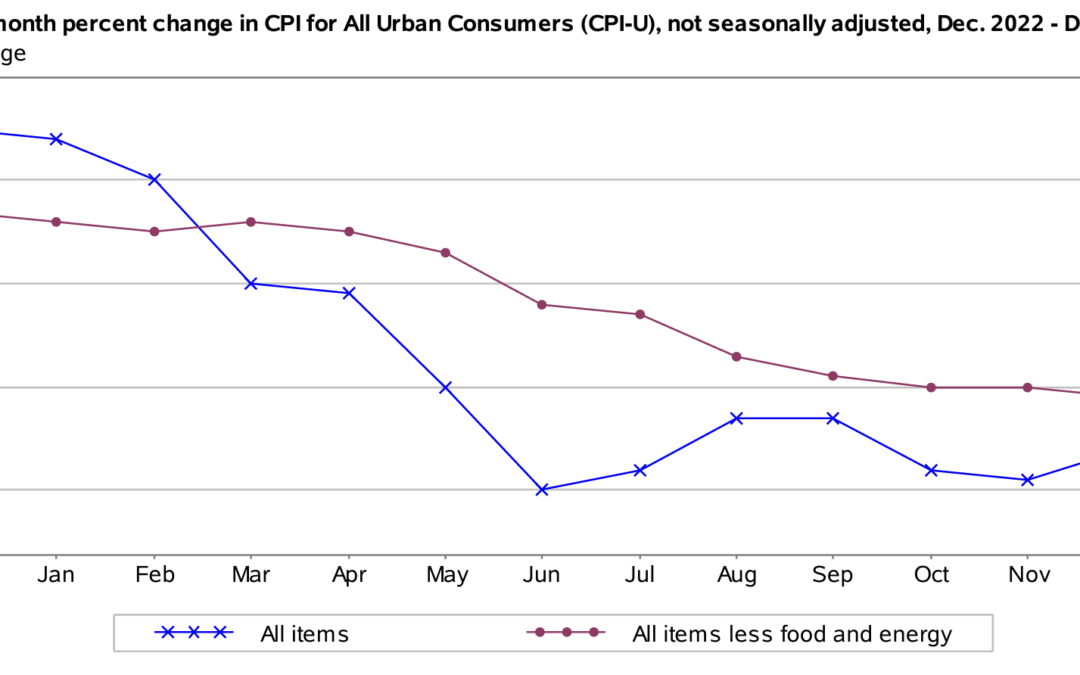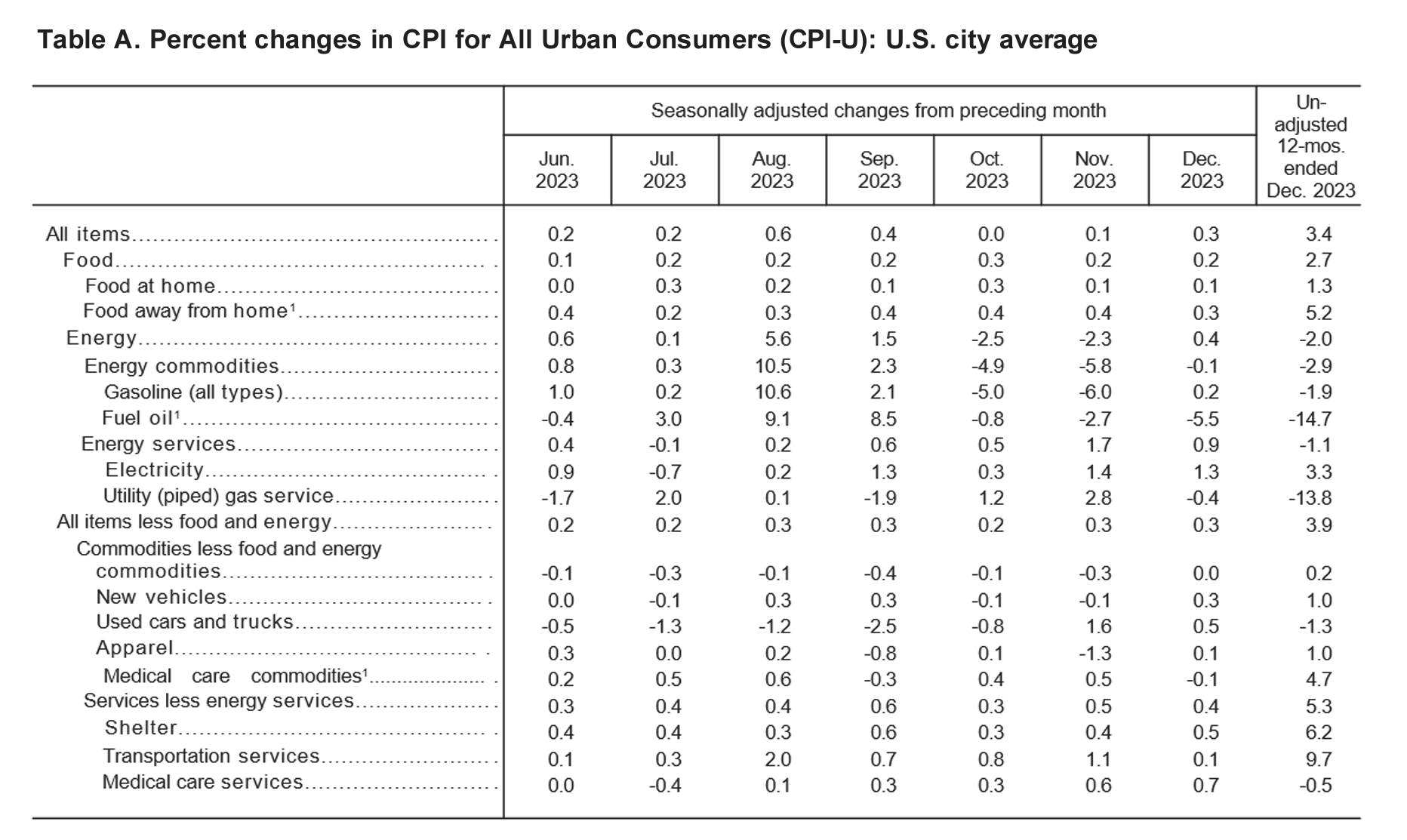The December 2023 Consumer Price Index of All Urban Consumers (CPI-U) report indicates that inflation rose by 0.3% for the month, following a more moderate rise of 0.1% in November and remaining unchanged in October. These data were released at 8:30 am EST on Thursday, January 11, 2024, by the Bureau of Labor Statistics. Before seasonal adjustment, the year-over-year (Y-o-Y) inflation rate in the all-items index grew by 3.4%, marking a notable acceleration from previous months.
This month’s CPI read exceeded expectations. Economists anticipated a rise of 0.2% month-over-month and a 3.2% Y-o-Y increase. Given December’s hotter-than-expected inflation data, market watchers are right to question whether this will delay the Fed’s dovish pivot slated for later this year. The current Fed interest rate sits at 5.5%, a 22-year high, and borrowers and investors alike are hotly anticipating interest rate relief as inflation comes under control. However, this month’s CPI report suggests that relief may be further away than originally thought.
Reactions were mostly negative in the stock market in response to today’s inflation news. As of 9:45 am EST, the Dow Jones Industrial Average was down 26.49 points.
According to the Associated Press, this month’s inflation rise was fueled in large part by rising food and housing prices. Food and energy costs tend to be volatile relative to other consumer goods. Excluding these items from the CPI, core prices rose only 0.3% month-over-month, unchanged from November’s increase. The upside is that, on a Y-o-Y basis, core prices rose by just 3.9%, which is the softest increase in core consumer prices since May 2021 and a notable decline from the previous month’s 4% Y-o-Y gain.
Despite positive news regarding core CPI prices, this month’s report nonetheless casts doubt on whether the Fed’s target inflation rate of 2% is attainable in the near term. Headline inflation remains considerably higher than both the Fed and everyday consumers would like.
Source: Bureau of Labor Statistics
Food Prices
The food index rose by 0.2 percent in December, increasing at the same rate seen in November. The index for food at home rose by 0.1 percent, which is also consistent with the previous month’s increase. Food away from home fared worse, with a 5.2 percent increase on the year. Notably, the index for meats, poultry, eggs, and fish increased by 0.5 percent due largely to a strong 8.9 percent increase in the egg index. This marks a major acceleration from November’s decrease in the same index by 0.2 percent. On a Y-o-Y basis, the food at home index rose by 1.3 percent, which marks a decline from November’s 1.7 percent acceleration on a 12-month basis.
Energy Prices
Lower energy costs were the main price category that pulled inflation down in December. The energy index rose 0.4 percent in December following a 2.3 percent decrease in the previous month and an even larger 2.5 percent decrease in October. The natural gas index fell by 0.4 percent over the month, coming on the heels of a sizable 2.8 percent increase in November. Similarly, the fuel oil index fell by 5.5 percent in this month’s report. On the year, the natural gas index fell by 13.8 percent, the gasoline index fell by 1.9 percent, and the fuel oil index fell by 14.7 percent. On the other hand, the index for electricity saw a 3.3 percent increase.
Core December 2023 CPI
Regarding the core CPI data for December 2023 (i.e., inflation less food and energy), the index rose 0.3 percent month-over-month, rising by the same margin seen in November. However, the index rose by 3.9 percent on a Y-o-Y basis, down slightly from November’s 4.0 percent decline. Below is an itemized breakdown of the main price fluctuations seen in December’s core CPI reading:
- Shelter index: (+0.5%) [November: +0.4%]
- Rent index: (+0.4%) [November: +0.5%]
- Personal care items: (-0.3%)
- Lodging away from home: (+0.4%)
- Motor vehicle insurance: (+1.5%) [November: +1.0%]
- Medical care index: (+0.6%) [Unchanged from November]
- Used cars and trucks: (+0.5%) [November: +1.6%]
- Household furnishings and operations: (-0.4%) [Unchanged from November]
Source: Bureau of Labor Statistics
Seasonally Unadjusted CPI Data for December 2023
Before seasonal adjustments, the CPI-U for December 2023 increased (+3.4%) year-over-year, rising to an index level of 306.746. Since these figures are unadjusted, they include regular seasonal price fluctuations that generally occur by the same margins every year.
Source: Bureau of Labor Statistics
While Stubborn Inflation Rings in the New Year, Gold Soars
Supply-side constraints, fueled in large part by disruptions and violence in the Red Sea, have stoked inflationary flames. While the pundit class decries the difficulties of “last mile” inflation, there is little indication that the Fed’s target rate of 2% is achievable within H1 2024. An increasing chorus of economists are now looking to the summer as the most likely time frame for any potential rate cut.
In the meantime, American households are suffering. High inflation has significantly reduced the purchasing power of American families over the past two years, with rising healthcare costs leading the way. Despite strong job growth, Americans aren’t feeling any relief. The long-lasting effects of inflation have left a lasting mark on everyday consumers, with about 75% of Americans describing the economy as “poor”.
The truth is that the word “poor” is a gross understatement. Behind the cheery backdrop of high spending and GDP growth is a grimmer reality: Americans have record levels of debt, increasingly unaffordable housing, sky-high borrowing costs, and stagnant wages that aren’t keeping up with the cost of essential goods.
The upside, however, is that there are well-performing assets that may provide relief for American investors. In December, the spot price of gold broke its all-time high, hitting $2,135 per ounce before stabilizing around $2,050. Bitcoin and Ethereum, riding on the launch of widely-anticipated cryptocurrency ETFs, have also rallied in double digits over the past few months.
The recessions of 2008 and 2020 have shown that gold and silver can outperform traditional securities when financial markets are in decline. For many investors, gold acts as a reliable hedge against inflation, offering a stable store of value when others are not. Investing in gold and silver can serve as a protective measure for your savings against the devaluation of the U.S. dollar, allowing you to preserve your wealth during times of inflation.
Considering diversifying your portfolio with gold or silver? You can take the first step by opening an account with one of the top-rated gold IRA service providers. In the meantime, you can use our complimentary CPI inflation calculator tool to monitor how inflation is affecting your household’s finances. Always consult with a financial advisor before making any investment decision.






